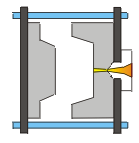U.S. manufacturing technology consumption totaled $153.55 million for September , according to AMTDA, the American Machine Tool Distributors’ Association, and AMT — The Association For Manufacturing Technology. This total was up 17.8% from August but down 69.3% from the total …
Continue reading
Category Archives: Die Casting Alloys
Aluminum Cast Parts are Widely Used in 2024
In the world of manufacturing and engineering, aluminum cast parts play a crucial role in creating a wide range of products. From automotive components to aerospace parts, aluminum castings are highly valued for their versatility, durability, and cost-effectiveness. In this blog post, we will delve into the reasons why aluminum cast parts are widely used in various industries across the globe.
What Are Die Casting Parts?
Aluminum is a lightweight metal known for its excellent strength-to-weight ratio, making it an ideal material for producing cast parts that need to be both sturdy and lightweight. Through the casting process, aluminum can be shaped into complex geometries with precision and accuracy, allowing for the creation of components that are tailored to specific requirements. This versatility in design is a key advantage of aluminum cast parts, as it enables manufacturers to produce parts that are both functional and aesthetically pleasing.
One of the main reasons why aluminum cast parts are favored in the manufacturing industry is their cost-effectiveness. Aluminum is abundant and relatively inexpensive compared to other metals, making it a cost-effective option for producing a wide range of components. Furthermore, the casting process itself is efficient and requires minimal post-processing, reducing production time and costs. This makes aluminum cast parts an attractive choice for companies looking to optimize their manufacturing processes without compromising on quality.
Another factor that contributes to the widespread use of aluminum cast parts is their excellent corrosion resistance. Aluminum naturally forms a protective oxide layer on its surface, which helps prevent rust and corrosion, making it ideal for applications in harsh environments or exposed to the elements. This corrosion resistance ensures the longevity of aluminum cast parts, reducing maintenance costs and extending the lifespan of products.
Furthermore, aluminum cast parts offer excellent thermal conductivity, making them ideal for applications that require heat dissipation or thermal management. This property is particularly valuable in industries such as automotive, aerospace, and electronics, where efficient heat transfer is essential for optimal performance and safety. By utilizing aluminum cast parts, manufacturers can ensure that their products operate at peak efficiency while maintaining stable temperatures.
In addition to their mechanical properties, aluminum cast parts are also highly recyclable, making them a sustainable choice for environmentally conscious companies. Aluminum is endlessly recyclable without losing its inherent properties, reducing the demand for primary aluminum production and lowering carbon emissions. By choosing aluminum castings, manufacturers can contribute to a more sustainable future while meeting their production needs.
Aluminum cast parts are widely used in various industries due to their exceptional properties, cost-effectiveness, and sustainability. Whether it’s for automotive components, aerospace structures, or consumer electronics, aluminum castings offer a myriad of benefits that make them a preferred choice for manufacturers worldwide. As technology advances and industries evolve, aluminum cast parts will continue to play a vital role in shaping the products we rely on every day.
“The Parts We Make Today, We Ship Today”
Kinetic Die Casting Company. Inc.
6918 Beck Avenue, North Hollywood,
California 91605, United States of America
E-mail sales@kineticdc.com
USA Toll Free: (800) 524-8083 Local: (818) 982-9200
To get prices for Die Casting Tooling Molds or Parts:
RFQ Die Casting Tooling Part Prices
Kinetic Die Casting Company makes:
Die Casting Aluminum Heat Sinks
Aluminum Boxes Diecastings
Zinc Die Casting and Its Use on Tools
 Zinc Die Casting and Its Use on Tools. Hardware parts are chiefly made of metal. It is the most common material used for the production of tools because of its strength and robustness. Repairs, after all, need fortitude not only from the wielder of the tool but from the tool itself. A flexible screwdriver, after all, is not good in execution of its function if it is made of inferior material.
Zinc Die Casting and Its Use on Tools. Hardware parts are chiefly made of metal. It is the most common material used for the production of tools because of its strength and robustness. Repairs, after all, need fortitude not only from the wielder of the tool but from the tool itself. A flexible screwdriver, after all, is not good in execution of its function if it is made of inferior material.
One process of manufacturing tools and other metal parts is zinc die casting. Hardware parts such as wrenches, electrical connectors, gearbox and turbine housings, and locks can be made out of zinc. This metal is a decent foundation of raw material because it shows characteristics that are primary in the mind of an astute customer: strength, ductility, and durability.
The strength, ductility, and durability alone are enough to persuade any person to change to materials made from zinc die casting. Zinc hardware parts made from zinc are assured to be durable, able to endure strong impacts from hammering, screwing, and bolting.
Apart from tools, zinc is also used in the construction of wires, parts of appliances and laptops, lights, aircrafts, and other objects. It can be used in various products because of its flexibility and endurance.
Construction and repair are two activities that need dependence on human forte as well as tools. It is but appropriate that the tools used in these activities match the stress and pressure essential by the jobs. Objects made of zinc may just be the best match for people who are looking for such.
Kinetic Die Casting Company, Inc.
6918 Beck Avenue, North Hollywood, CA 91605
818-982-9200
Sales@kineticdc.com
Sponsored Listings:
Die Casting Comparison of Zinc Parts and Aluminum Parts in 2023
Die Casting Comparison of Zinc Parts and Aluminum Parts. Kinetic Die Casting Company produces parts for our customers in two types of metals. Aluminum and Zinc alloys. Most of the parts we produce are in aluminum.
When we get a quote request that does not specify the materiel, we ask a few questions to determine which metal would be better for them.
- Does weight matter? Zinc weighs about two and half (2.44) times more than aluminum. In other words, a part that weighs five (5) pounds in aluminum will weigh over twelve (12.22) pounds in zinc.
- Do you need EMI/RF shielding? Do you need electrical conductivity? Aluminum is much more electrically conductive than zinc, making it a better shield for RF/EMI.
- Do you need thermal conductivity? Aluminum is used by many manufacturers as a heat sink.
- Do you want parts with a highly polished finished surface? Zinc polishes very well, much better than aluminum.
- Do you need your parts plated? Zinc parts can be plated much better than aluminum.
- Are you intending to use the parts in a salt environment? Aluminum decays faster than zinc in a salty environment.
See our blog:
https://www.kineticdiecasting.com/kdc/
Whether, you need die casting parts produced in aluminum or in zinc, contact Kinetic Die Casting Company to purchase your parts or die casting tooling.
Contact Kinetic Die Casting Company to buy
Links:
Kinetic Die Casting manufactures die cast parts for their customers. If you would like to know more about what is die casting or if you would like a quote, please visit our website:Kinetic Die Casting Company
“The Parts We Make Today, We Ship Today”
Kinetic Die Casting Company. Inc.
6918 Beck Avenue, North Hollywood,
California 91605, United States of America
E-mail sales@kineticdc.com
USA Toll Free: (800) 524-8083 Local: (818) 982-9200
To get prices for Die Casting Tooling Molds or Parts:
RFQ Die Casting Tooling Part Prices
Kinetic Die Casting Company makes:

Die Casting Supervisor Job August 2023
08/10/2023 – For nearly 30 years, Kinetic Die Casting Company has been a small manufacturing company located in the Los Angeles, California area. We make aluminum die casting parts and zinc die casting parts for our manufacturing customers. We are looking to hire a Die Casting Production Supervisor. This is a full time job, 40 hours a week, for a person experienced in die casting supervision or manufacturing supervision. This person will sometimes assist with production scheduling, supervise die casting machine operators, supervise die casting machine setups, and supervise production personnel. This person should already live in Southern California to be considered. No job applicants from other countries will be considered.
Thank you. Contact us Soon
Kinetic Die Casting Company, Inc
(www.kineticdiecasting.com/)
6918 Beck Avenue
North Hollywood, CA 91605
Email Resume: sales@kineticdc.com
Call for an appointment: 818-982-9200
#hire #job #employment #diecasting #supervisor #manufacturing


